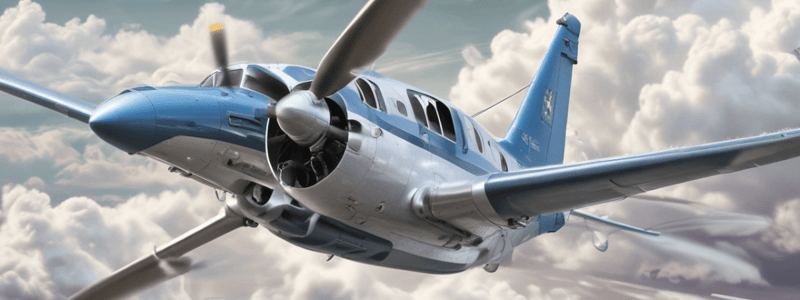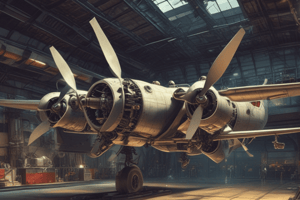Podcast
Questions and Answers
What is a primary advantage of using composite materials in propeller blades?
What is a primary advantage of using composite materials in propeller blades?
- Improved strength and flexibility (correct)
- Simplified manufacturing process
- Reduced cost
- Increased weight
What is the main benefit of variable-pitch propellers?
What is the main benefit of variable-pitch propellers?
- Improved climb rate
- Reduced maintenance requirements
- Increased fuel consumption
- Optimized performance in different phases of flight (correct)
How do advanced blade designs and tip technologies reduce noise in high-performance propellers?
How do advanced blade designs and tip technologies reduce noise in high-performance propellers?
- By reducing the propeller's RPM
- By increasing the blade angle
- By shaping the blade tips to minimize vortices (correct)
- By using a larger propeller diameter
What is the primary advantage of scimitar-shaped propellers?
What is the primary advantage of scimitar-shaped propellers?
What is the main benefit of contra-rotating propellers?
What is the main benefit of contra-rotating propellers?
Why are high-performance propellers particularly beneficial for operations in noise-sensitive areas?
Why are high-performance propellers particularly beneficial for operations in noise-sensitive areas?
What is a key feature of variable-pitch propellers?
What is a key feature of variable-pitch propellers?
How do contra-rotating propellers improve the efficiency of the propulsion system?
How do contra-rotating propellers improve the efficiency of the propulsion system?
What is a key benefit of optimizing the propeller's performance in different phases of flight?
What is a key benefit of optimizing the propeller's performance in different phases of flight?
What is a major advancement in propeller technology?
What is a major advancement in propeller technology?
The development of fixed-pitch propellers is a significant advancement in propeller technology.
The development of fixed-pitch propellers is a significant advancement in propeller technology.
High-performance propellers can only be used for takeoff and climb.
High-performance propellers can only be used for takeoff and climb.
Contra-rotating propellers recover the rotational energy lost in the propeller's thrust.
Contra-rotating propellers recover the rotational energy lost in the propeller's thrust.
The curved, swept-back blade tips of scimitar-shaped propellers increase drag and noise.
The curved, swept-back blade tips of scimitar-shaped propellers increase drag and noise.
The use of composite materials in propeller blades reduces strength and flexibility.
The use of composite materials in propeller blades reduces strength and flexibility.
Advanced blade designs and tip technologies increase the noise footprint of the aircraft.
Advanced blade designs and tip technologies increase the noise footprint of the aircraft.
Variable-pitch propellers can only change their blade pitch angle on the ground.
Variable-pitch propellers can only change their blade pitch angle on the ground.
The latest developments in propeller technology have a negligible impact on aircraft performance.
The latest developments in propeller technology have a negligible impact on aircraft performance.
High-performance propellers are only used for low-speed aircraft.
High-performance propellers are only used for low-speed aircraft.
Contra-rotating propellers are less efficient than traditional propellers.
Contra-rotating propellers are less efficient than traditional propellers.
What is the primary reason for utilizing intricate blade shapes in high-performance propellers?
What is the primary reason for utilizing intricate blade shapes in high-performance propellers?
How do variable-pitch propellers adjust their performance to suit different phases of flight?
How do variable-pitch propellers adjust their performance to suit different phases of flight?
What is the primary benefit of reducing the noise footprint of an aircraft?
What is the primary benefit of reducing the noise footprint of an aircraft?
What is the purpose of shaping the blade tips to minimize vortices and resulting pressure differences?
What is the purpose of shaping the blade tips to minimize vortices and resulting pressure differences?
What is the characteristic shape of scimitar-shaped propellers?
What is the characteristic shape of scimitar-shaped propellers?
What is the primary advantage of contra-rotating propellers?
What is the primary advantage of contra-rotating propellers?
What is the result of optimizing the propeller's performance in different phases of flight?
What is the result of optimizing the propeller's performance in different phases of flight?
What is the main advantage of using composite materials in propeller blades?
What is the main advantage of using composite materials in propeller blades?
How do high-performance propellers improve aircraft performance?
How do high-performance propellers improve aircraft performance?
What is the primary benefit of using advanced blade designs and tip technologies?
What is the primary benefit of using advanced blade designs and tip technologies?
Flashcards are hidden until you start studying
Study Notes
High-Performance Propellers
- High-performance propellers are designed to deliver superior power, speed, and efficiency, making them a crucial component in an aircraft's propulsion.
- They are engineered to withstand faster rotation speeds and higher temperatures, achieving high-performance status through innovations in materials and construction techniques.
Advanced Materials and Construction
- Carbon fiber and advanced alloys are used to strike a balance between strength and lightness, allowing for the creation of blades that can withstand faster rotation speeds and higher temperatures.
- The use of these materials enables the creation of blades with intricate shapes, tailored to specific flight profiles.
Aerodynamic Enhancements
- Higher blade curvature and variable pitch allow for increased acceleration and maneuverability, adjusting for better performance under various flight conditions.
- The shape of each blade, the curve, and the angle (pitch) are carefully designed to optimize aerodynamic performance.
Propeller Design and Efficiency
- Propeller efficiency is a measure of how well a propeller converts engine power into thrust.
- High-performance propellers are designed with advanced aerodynamic blades that can maintain optimal efficiency across a wider range of speeds and conditions.
Variable-Pitch Propellers
- Variable-pitch propellers can change their blade pitch angle in flight, allowing pilots to adjust the propeller's performance to suit different phases of flight (e.g., takeoff, climb, cruise, or descent).
- By optimizing the pitch angle, these propellers can maintain a higher efficiency over a broader range of conditions, resulting in better fuel economy and longer range.
Noise Reduction
- Noise reduction is a key area of focus in high-performance propeller design, with advanced blade designs and tip technologies used to minimize noise.
- Techniques such as shaping the blade tips to minimize vortices and resulting pressure differences reduce noise, making them suitable for operations in noise-sensitive areas.
Scimitar-Shaped Propeller
- The scimitar-shaped propeller is a high-performance design that features curved, swept-back blade tips, reducing drag and noise while increasing thrust.
- This design is well-suited for high-speed aircraft.
Contra-Rotating Propellers
- Contra-rotating propellers involve two sets of propellers placed one behind the other on the same axis, rotating in opposite directions.
- This arrangement can significantly increase the thrust generated by the propellers and improve the efficiency of the propulsion system by recovering the rotational energy lost in the slipstream of the first propeller.
Impact on Aircraft Performance
- The latest developments in propeller technology significantly enhance aircraft performance, including fuel efficiency, climb rates, and cruise speeds.
- These advancements also contribute to a higher level of safety and reliability.
High-Performance Propellers
- High-performance propellers are designed to deliver superior power, speed, and efficiency, making them a crucial component in an aircraft's propulsion.
- They are engineered to withstand faster rotation speeds and higher temperatures, achieving high-performance status through innovations in materials and construction techniques.
Advanced Materials and Construction
- Carbon fiber and advanced alloys are used to strike a balance between strength and lightness, allowing for the creation of blades that can withstand faster rotation speeds and higher temperatures.
- The use of these materials enables the creation of blades with intricate shapes, tailored to specific flight profiles.
Aerodynamic Enhancements
- Higher blade curvature and variable pitch allow for increased acceleration and maneuverability, adjusting for better performance under various flight conditions.
- The shape of each blade, the curve, and the angle (pitch) are carefully designed to optimize aerodynamic performance.
Propeller Design and Efficiency
- Propeller efficiency is a measure of how well a propeller converts engine power into thrust.
- High-performance propellers are designed with advanced aerodynamic blades that can maintain optimal efficiency across a wider range of speeds and conditions.
Variable-Pitch Propellers
- Variable-pitch propellers can change their blade pitch angle in flight, allowing pilots to adjust the propeller's performance to suit different phases of flight (e.g., takeoff, climb, cruise, or descent).
- By optimizing the pitch angle, these propellers can maintain a higher efficiency over a broader range of conditions, resulting in better fuel economy and longer range.
Noise Reduction
- Noise reduction is a key area of focus in high-performance propeller design, with advanced blade designs and tip technologies used to minimize noise.
- Techniques such as shaping the blade tips to minimize vortices and resulting pressure differences reduce noise, making them suitable for operations in noise-sensitive areas.
Scimitar-Shaped Propeller
- The scimitar-shaped propeller is a high-performance design that features curved, swept-back blade tips, reducing drag and noise while increasing thrust.
- This design is well-suited for high-speed aircraft.
Contra-Rotating Propellers
- Contra-rotating propellers involve two sets of propellers placed one behind the other on the same axis, rotating in opposite directions.
- This arrangement can significantly increase the thrust generated by the propellers and improve the efficiency of the propulsion system by recovering the rotational energy lost in the slipstream of the first propeller.
Impact on Aircraft Performance
- The latest developments in propeller technology significantly enhance aircraft performance, including fuel efficiency, climb rates, and cruise speeds.
- These advancements also contribute to a higher level of safety and reliability.
High-Performance Propellers
- High-performance propellers are designed to deliver superior power, speed, and efficiency, making them a crucial component in an aircraft's propulsion.
- They are engineered to withstand faster rotation speeds and higher temperatures, achieving high-performance status through innovations in materials and construction techniques.
Advanced Materials and Construction
- Carbon fiber and advanced alloys are used to strike a balance between strength and lightness, allowing for the creation of blades that can withstand faster rotation speeds and higher temperatures.
- The use of these materials enables the creation of blades with intricate shapes, tailored to specific flight profiles.
Aerodynamic Enhancements
- Higher blade curvature and variable pitch allow for increased acceleration and maneuverability, adjusting for better performance under various flight conditions.
- The shape of each blade, the curve, and the angle (pitch) are carefully designed to optimize aerodynamic performance.
Propeller Design and Efficiency
- Propeller efficiency is a measure of how well a propeller converts engine power into thrust.
- High-performance propellers are designed with advanced aerodynamic blades that can maintain optimal efficiency across a wider range of speeds and conditions.
Variable-Pitch Propellers
- Variable-pitch propellers can change their blade pitch angle in flight, allowing pilots to adjust the propeller's performance to suit different phases of flight (e.g., takeoff, climb, cruise, or descent).
- By optimizing the pitch angle, these propellers can maintain a higher efficiency over a broader range of conditions, resulting in better fuel economy and longer range.
Noise Reduction
- Noise reduction is a key area of focus in high-performance propeller design, with advanced blade designs and tip technologies used to minimize noise.
- Techniques such as shaping the blade tips to minimize vortices and resulting pressure differences reduce noise, making them suitable for operations in noise-sensitive areas.
Scimitar-Shaped Propeller
- The scimitar-shaped propeller is a high-performance design that features curved, swept-back blade tips, reducing drag and noise while increasing thrust.
- This design is well-suited for high-speed aircraft.
Contra-Rotating Propellers
- Contra-rotating propellers involve two sets of propellers placed one behind the other on the same axis, rotating in opposite directions.
- This arrangement can significantly increase the thrust generated by the propellers and improve the efficiency of the propulsion system by recovering the rotational energy lost in the slipstream of the first propeller.
Impact on Aircraft Performance
- The latest developments in propeller technology significantly enhance aircraft performance, including fuel efficiency, climb rates, and cruise speeds.
- These advancements also contribute to a higher level of safety and reliability.
Studying That Suits You
Use AI to generate personalized quizzes and flashcards to suit your learning preferences.



